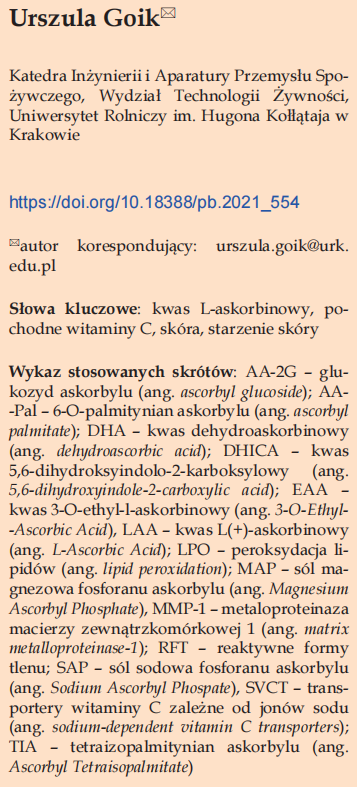文献精选
STRESZCZENIE Witamina C jest składnikiem odżywczym niezbędnym dla zdrowia człowieka posiada jącym duży potencjał jako kosmeceutyk chroniący zdrowie i dobrą kondycję skóry. Poprzez stymulację biosyntezy kolagenu wpływa na fizjologię ludzkiej skóry, w szczególności biorąc udział w procesie hydroksylacji proliny i lizyny oraz uczestniczy w odbudowie tkanek podczas gojenia się ran. Jej niedobór wywołuje nieprawidłowości w funkcjonowaniu naczyń krwionośnych, naskórka i skóry właściwej. Naskórek i skóra właściwa są najbardziej narażone na działanie wolnych rodników pochodzących ze środowiska zewnętrznego oraz z wnętrza organizmu. Witamina C jest skutecznym antyoksydantem neutralizującym wolne rodniki, zapobiega procesom zapalnym i kancerogennym. W chorobach zapalnych skóry, przykładowo takich jak atopowe zapalenie skóry, łuszczyca, ilość witaminy C w skó-rze właściwej jest obniżona. Dlatego też dostarczanie jej do skóry z wykorzystaniem preparatów kosmetycznych jest ważnym elementem, nie tylko kosmetycznym, ale i zdrowotnym. Problemem związanym z wprowadzaniem witaminy C przy pomocy kosmetyków jest jej ograniczone przenikanie przez stratum corneum. Obecne badania koncentrują się na poszukiwaniu stabilnych związków kwasu askorbinowego i nowych nośników pozwalających na dostarczanie go do skóry właściwej.

Zhi Su 1,†, Qianhua Hu 1,†, Xiang Li 1 , Zirun Wang 1 and Ying Xie 1,2,*
1 Key Laboratory of Molecular Epidemiology of Hunan Province, School of Medicine, Hunan Normal University, Changsha 410081, China
2 Key Laboratory of Model Animals and Stem Cell Biology in Hunan Province, School of Medicine, Hunan Normal University, Changsha 410081, China
* Correspondence: 该Email地址已收到反垃圾邮件插件保护。要显示它您需要在浏览器中启用JavaScript。
† These authors contributed equally to this work.
Abstract: Circadian rhythms, the internal timekeeping systems governing physiological processes, significantly influence skin health, particularly in response to ultraviolet radiation (UVR). Disruptions in circadian rhythms can exacerbate UVR-induced skin damage and increase the risk of skin aging and cancer. This review explores how circadian rhythms affect various aspects of skin physiology and pathology, with a special focus on DNA repair. Circadian regulation ensures optimal DNA repair following UVR-induced damage, reducing mutation accumulation, and enhancing genomic stability. The circadian control over cell proliferation and apoptosis further contributes to skin regeneration and response to UVR. Oxidative stress management is another critical area where circadian rhythms exert influence. Key circadian genes like brain and muscle ARNT-like 1 (BMAL1) and circadian locomotor output cycles kaput (CLOCK) modulate the activity of antioxidant enzymes and signaling pathways to protect cells from oxidative stress. Circadian rhythms also affect inflammatory and immune responses by modulating the inflammatory response and the activity of Langerhans cells and other immune cells in the skin. In summary, circadian rhythms form a complex defense network that manages UVRinduced damage through the precise regulation of DNA damage repair, cell proliferation, apoptosis, inflammatory response, oxidative stress, and hormonal signaling. Understanding these mechanisms provides insights into developing targeted skin protection and improving skin cancer prevention.
Keywords: ultraviolet radiation; DNA damage repair; circadian rhythms; skin photoaging
Citation: Su, Z.; Hu, Q.; Li, X.; Wang, Z.; Xie, Y. The Influence of Circadian Rhythms on DNA Damage Repair in Skin Photoaging. Int. J. Mol. Sci. 2024, 25, 10926. https://doi.org/10.3390/ ijms252010926
Academic Editor: Ashis Basu
Received: 15 August 2024
Revised: 29 September 2024
Accepted: 8 October 2024
Published: 11 October 2024
Copyright: © 2024 by the authors. Licensee MDPI, Basel, Switzerland.
This article is an open access article distributed under the terms and conditions of the Creative Commons Attribution (CC BY) license (https:// creativecommons.org/licenses/by/ 4.0/)
Patrick Bogdanowicz 1,4*, Paul Bensadoun 2,4, Maïté Noizet 1 , Benoît Béganton 1 , Armony Philippe 1 , SandrineAlvarez‑Georges 1 , Gautier Doat 3 , AmélieTourette 1 , Sandrine Bessou‑Touya 1 , Jean‑Marc Lemaitre 2* & Hélène Duplan 1
1 R&D Pierre Fabre Dermo-Cosmétique & Personal Care, Toulouse, France.
2 INSERM IRMB UMR1183, Hôpital Saint Eloi, Université de Montpellier, Montpellier, France.
3 Laboratoires Dermatologiques Avène, Lavaur, France. 4These authors contributed equally: Patrick Bogdanowicz and Paul Bensadoun.
*email: 该Email地址已收到反垃圾邮件插件保护。要显示它您需要在浏览器中启用JavaScript。; 该Email地址已收到反垃圾邮件插件保护。要显示它您需要在浏览器中启用JavaScript。
Intrinsic and extrinsic factors, including lifestyle and sun exposure, can contribute to cell senescence, which impairs skin homeostasis, that may in turn lead to skin aging. Senescent cells have a specifc secretome, called the senescence-associated secretory phenotype (SASP) that includes MMPs, CXCLs and S100A8/9. Reducing the SASP with senotherapeutics is a promising strategy to reduce skin aging. Here we evaluated the efect of a formula containing niacinamide and hyaluronic acid, which are known to limit senescence and skin aging. We conducted three diferent studies. (1) Ex vivo explants treated with the formula had more collagen and glycosaminoglycan. (2) In a clinical trial with forty-four women, two months of treatment improved fne lines, wrinkles, luminosity, smoothness, homogeneity, and plumpness. (3) In a third study on thirty women, we treated one arm for two months and took skin biopsies to study gene expression. 101 mRNAs and 13 miRNAs were diferentially expressed. We observed a likely senomorphic efect, as there was a decrease in many SASP genes including MMP12 and CXCL9 and a signifcant downregulation of autocrine signaling genes: S100A8 and S100A9. These pharmaco-clinical results are the frst to demonstrate the senomorphic properties of an efective anti-aging formula in skin.
Radiofrequency Treatment Attenuates Age-Related Changes in Dermal–Epidermal Junctions of Animal Skin
Kyung-A Byun 1,2,3,†, Hyoung Moon Kim 4,† , Seyeon Oh 3 , Sosorburam Batsukh 1,3, Kuk Hui Son 5,* and Kyunghee Byun 1,3,6,*
1 Department of Anatomy & Cell Biology, College of Medicine, Gachon University, Incheon 21936, Republic of Korea
2 LIBON Inc., Incheon 22006, Republic of Korea
3 Functional Cellular Networks Laboratory, Lee Gil Ya Cancer and Diabetes Institute, Gachon University, Incheon 21999, Republic of Korea
4 Maylin Anti-Aging Center Ilsan, Goyang 10391, Republic of Korea
5 Department of Thoracic and Cardiovascular Surgery, Gachon University Gil Medical Center, Gachon University, Incheon 21565, Republic of Korea
6 Department of Health Sciences and Technology, Gachon Advanced Institute for Health & Sciences and Technology (GAIHST), Gachon University, Incheon 21999, Republic of Korea
* Correspondence: 该Email地址已收到反垃圾邮件插件保护。要显示它您需要在浏览器中启用JavaScript。 (K.H.S.); 该Email地址已收到反垃圾邮件插件保护。要显示它您需要在浏览器中启用JavaScript。 (K.B.); Tel.: +82-32-460-3666 (K.H.S.); +82-32-899-6511 (K.B.)
† These authors contributed equally to this work.
Abstract: The dermal–epidermal junction (DEJ) is essential for maintaining skin structural integrity and regulating cell survival and proliferation. Thus, DEJ rejuvenation is key for skin revitalization, particularly in age-related DEJ deterioration. Radiofrequency (RF) treatment, known for its ability to enhance collagen fiber production through thermal mechanisms and increase heat shock protein (HSP) expression, has emerged as a promising method for skin rejuvenation. Additionally, RF activates Piezo1, an ion channel implicated in macrophage polarization toward an M2 phenotype and enhanced TGF-β production. This study investigated the impact of RF treatment on HSP47 and HSP90 expression, known stimulators of DEJ protein expression. Furthermore, using in vitro and aged animal skin models, we assessed whether RF-induced Piezo1 activation and the subsequent M2 polarization could counter age-related DEJ changes. The RF treatment of H2O2 -induced senescent keratinocytes upregulated the expression of HSP47, HSP90, TGF-β, and DEJ proteins, including collagen XVII. Similarly, the RF treatment of senescent macrophages increased Piezo1 and CD206 (M2 marker) expression. Conditioned media from RF-treated senescent macrophages enhanced the expression of TGF-β and DEJ proteins, such as nidogen and collagen IV, in senescent fibroblasts. In aged animal skin, RF treatment increased the expression of HSP47, HSP90, Piezo1, markers associated with M2 polarization, IL-10, and TGF-β. Additionally, RF treatment enhanced DEJ protein expression. Moreover, RF reduced lamina densa replication, disrupted lesions, promoted hemidesmosome formation, and increased epidermal thickness. Overall, RF treatment effectively enhanced DEJ protein expression and mitigated age-related DEJ structural changes by increasing HSP levels and activating Piezo1.
Keywords: aged mice skin; bipolar; dermal–epidermal junction; heat shock protein; monopolar; Piezo1; radiofrequency
Citation: Byun, K.-A.; Kim, H.M.; Oh, S.; Batsukh, S.; Son, K.H.; Byun, K. Radiofrequency Treatment Attenuates Age-Related Changes in Dermal–Epidermal Junctions of Animal Skin. Int. J. Mol. Sci. 2024, 25, 5178. https://doi.org/10.3390/ ijms25105178
Academic Editor: Terrence Piva
Received: 16 April 2024
Revised: 3 May 2024
Accepted: 7 May 2024
Published: 9 May 2024
Copyright: © 2024 by the authors. Licensee MDPI, Basel, Switzerland. This article is an open access article distributed under the terms and conditions of the Creative Commons Attribution (CC BY) license (https:// creativecommons.org/licenses/by/ 4.0/).




